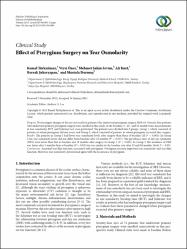Effect of Pterygium Surgery on tear osmolarity

View/
Access
info:eu-repo/semantics/openAccessDate
2013Author
Türkyılmaz, KemalÖner, Veysi
Sevim, Mehmet Şahin
Kurt, Ali
Şekeryapan, Berrak
Durmuş, Mustafa
Metadata
Show full item recordCitation
Türkyılmaz, K., Öner, V., Sevim, MS., Kurt, A., Şekeryapan, B., Durmuş, M. (2013). Effect of Pterygium Surgery on tear osmolarity. Journal of Ophthalmology, 2013, 863498.Abstract
Purpose. To investigate changes of dry eye test results in patients who underwent pterygium surgery. Methods. Seventy-four patients who underwent primary pterygium surgery were enrolled in this study. At the baseline, 3-, 12-, and 18-month visits, measurements of tear osmolarity, BUT, and Schirmer test were performed.. e patients were divided into 2 groups: Group 1, which consisted of patients in whom pterygium did not recur, and Group 2, which consisted of patients in whom pterygium recurred a. er surgery. Results.. e patients in Group 1 had lower tear osmolarity levels a. er surgery than those at baseline (all P < 0.001). in Group 2 the tear osmolarity levels did not differ from baseline and 18 months (P = 0.057). the prevalence rates of dry eye syndrome (DES) were lower than that at baseline and 18 months and surgery in Group 1 (P = 0.002). in Group 2, the incidence of DES was lower and 3 months than at baseline (P = 0.03.) but was similar to the baseline rate a. er 12 and 18 months (both P > 0.05). Conclusions. Anormal tear film function associated with pterygium. Pterygium excision improved tear osmolarity and tear film function. However, tear osmolarity deteriorated again with the recurrence of pterygium.

















